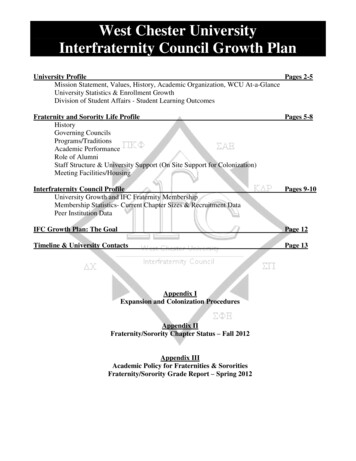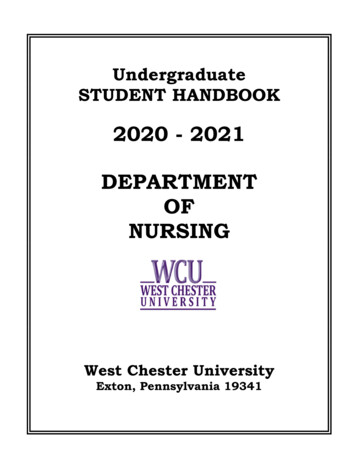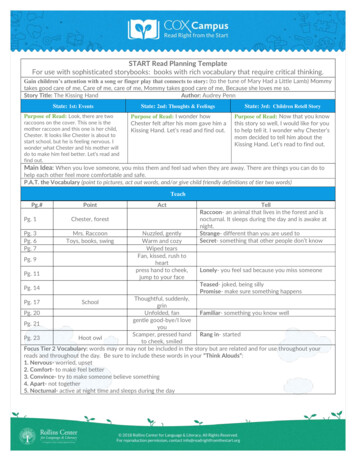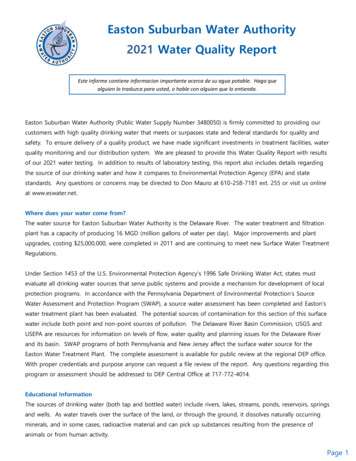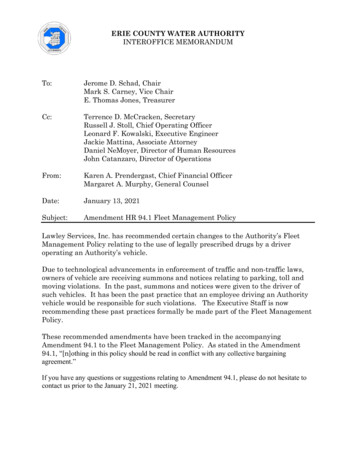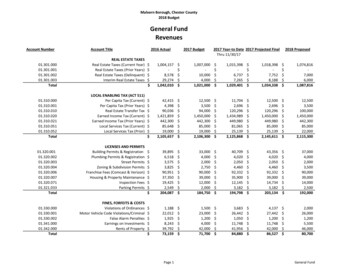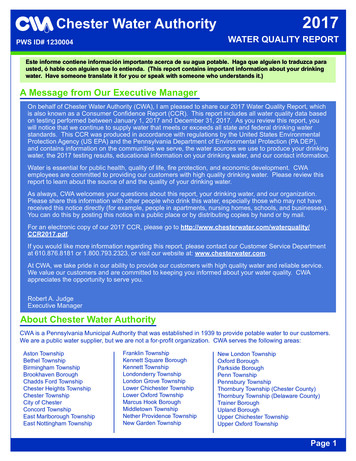
Transcription
2016 Chester Water AuthorityPWS ID# 12300042017WATER QUALITY REPORTEste informe contiene información importante acerca de su agua potable. Haga que alguien lo traduzca parausted, ó hable con alguien que lo entienda. (This report contains important information about your drinkingwater. Have someone translate it for you or speak with someone who understands it.)A Message from Our Executive ManagerOn behalf of Chester Water Authority (CWA), I am pleased to share our 2017 Water Quality Report, whichis also known as a Consumer Confidence Report (CCR). This report includes all water quality data basedon testing performed between January 1, 2017 and December 31, 2017. As you review this report, youwill notice that we continue to supply water that meets or exceeds all state and federal drinking waterstandards. This CCR was produced in accordance with regulations by the United States EnvironmentalProtection Agency (US EPA) and the Pennsylvania Department of Environmental Protection (PA DEP),and contains information on the communities we serve, the water sources we use to produce your drinkingwater, the 2017 testing results, educational information on your drinking water, and our contact information.Water is essential for public health, quality of life, fire protection, and economic development. CWAemployees are committed to providing our customers with high quality drinking water. Please review thisreport to learn about the source of and the quality of your drinking water.As always, CWA welcomes your questions about this report, your drinking water, and our organization.Please share this information with other people who drink this water, especially those who may not havereceived this notice directly (for example, people in apartments, nursing homes, schools, and businesses).You can do this by posting this notice in a public place or by distributing copies by hand or by mail.For an electronic copy of our 2017 CCR, please go to df.If you would like more information regarding this report, please contact our Customer Service Departmentat 610.876.8181 or 1.800.793.2323, or visit our website at: www.chesterwater.com.At CWA, we take pride in our ability to provide our customers with high quality water and reliable service.We value our customers and are committed to keeping you informed about your water quality. CWAappreciates the opportunity to serve you.Robert A. JudgeExecutive ManagerAbout Chester Water AuthorityCWA is a Pennsylvania Municipal Authority that was established in 1939 to provide potable water to our customers.We are a public water supplier, but we are not a for-profit organization. CWA serves the following areas:Aston TownshipBethel TownshipBirmingham TownshipBrookhaven BoroughChadds Ford TownshipChester Heights TownshipChester TownshipCity of ChesterConcord TownshipEast Marlborough TownshipEast Nottingham TownshipFranklin TownshipKennett Square BoroughKennett TownshipLondonderry TownshipLondon Grove TownshipLower Chichester TownshipLower Oxford TownshipMarcus Hook BoroughMiddletown TownshipNether Providence TownshipNew Garden TownshipNew London TownshipOxford BoroughParkside BoroughPenn TownshipPennsbury TownshipThornbury Township (Chester County)Thornbury Township (Delaware County)Trainer BoroughUpland BoroughUpper Chichester TownshipUpper Oxford TownshipPage 1
Where Does Your Water Come From?The water treated at the Octoraro Treatment Plantcomes from two sources: the Octoraro Reservoir andthe Susquehanna River. Both of these sources are inthe Susquehanna River Basin. The water is treatedand pumped to our customers from the CWA OctoraroTreatment Plant which produces an average of 30million gallons per day.The US EPA and PA DEP have established regulationsthat require public water systems to monitor forcertain contaminants. They have also set limits forthe amounts of contaminants that may be present indrinking water.(Octoraro Reservoir in Lancaster County, PA)As your water supplier, we recognize that contaminants may be present in source waters and we operatethe treatment processes of the Octoraro Treatment Plant to ensure the water we provide to our customersmeets all drinking water standards.Source Water Protection Plan and Source Water AssessmentsIn 1988, a Source Water Assessment (SWA) of the Octoraro Reservoir was completed by the CadmusGroup. The SWA identified and ranked sources of potential threats of source water contamination. The SWAindicated that the Octoraro Reservoir was most susceptible to contamination by nutrients and sediments fromagricultural activity. Other potential sources of contamination include spills from roads and bridges, residentialand municipal wastewater treatment, urban storm water runoff and industrial discharges. To better protect thesource water in the Octoraro Reservoir, CWA and PA DEP used the SWA as a foundation to develop a SourceWater Protection Plan (SWPP) that was finalized in July 2015. The SWPP is a voluntary effort by interestedparties or stakeholders to take action to prevent contaminants from entering CWA’s Octoraro Reservoir.The goal of the SWPP is to improve and protect the quality of the surfacewater within the Octoraro’s 139 square mile watershed and within the OctoraroReservoir. Improved water quality will benefit our customer’s drinking water, aswell as residents and businesses within the watershed. CWA hosts an annualsteering committee meeting to continue protection efforts and to gain publicparticipation and support. The steering committee is made up of residents,township officials, regulators, conservation districts, and other partneringstakeholders. The stakeholders include the Octoraro Watershed AssociationSafe Drinking Water(OWA), the Alliance for the Chesapeake Bay, the Chester County WaterResources Authority, and the Lancaster County and Chester County Conservation Districts.Starts at the Source!In addition to the Octoraro SWPP, the Susquehanna River Basin Commission (SRBC) completed a SWA for theSusquehanna River Conowingo Pond in 2003. The SWA indicated that Conowingo Pond was most susceptibleto contamination from agricultural contaminants, spills from roads and bridges, and urban storm water runoff.Other potential sources of contamination include discharges from wastewater treatment plants, water treatmentplants, and industries. A summary report of the Susquehanna River Basin assessment is available on thePennsylvania Source Water Assessment website mComplete reports were distributed to municipalities, water suppliers, local planning agencies, and PA DEPoffices. Copies of the reports are available at the PA DEP Southeast Regional Office at 484.250.5110, or bycalling CWA at 1.800.217.7880.Information about the Octoraro Watershed Association (OWA) may be obtained by contacting OWA directly at517 Pine Grove Road, Nottingham, PA 19362, or by calling 1.717.529.2132.Page 2
Frequently Asked QuestionsWhy is my water discolored?If your water is rusty, yellowish, or brownish, the color is likely a result of iron or rust. This may occur when there isan upset in the distribution system (such as a water main break) or when the direction of water flow changes (suchas during hydrant use to extinguish a fire or during routine hydrant flushing). Discolored water may also result frominternal plumbing issues. A rust problem is usually short-lived and we recommend that you do not wash clothes if younotice discolored water because the clothes may stain. Flush your cold and hot water taps, after the water clears, tomake sure the rust does not accumulate or stay in your plumbing.Why does my water appear milky?When water is cold, such as during the winter, there is more air in it. When thecold water enters your home, the water warms up and air is released from thewater. The air in the water will give it a milky or cloudy appearance. So, whenyou open the faucet to fill a glass, the air is released as bubbles similar to whatyou see when shaking a soda. As the water sits in the glass, it will clear from thebottom of the glass to the top. The air is not harmful. The more air in the water,the longer it will take for the water to clear and more cloudy or milky it looks.Why is there pink slimy material in my toilet bowl, mypet’s dish, my sink drain, bathtub, or shower head?Bacteria grow well in these areas because they are moist and provide a food source for thebacteria to thrive on. The bacteria can be found in the air, in soil, in water, or on householdsurfaces. Orange and pink are common colors for many bacteria, but the bacteria known asSerratia marcescens is often the source of the “orangy/pink stuff”. This bacteria is not easilyeliminated from these areas. Periodic and routine cleaning of these areas followed by disinfectionwith a chlorine-based cleaner is the best way to control it.What are these black particles in my water?Black particles may arise from a broken household water filter that contains a carbon cartridge and the particles willlook like coffee grounds. If you see particles you should replace the cartridge. Black particles may also be a result ofa degrading faucet washer or gasket or a disintegrating black rubber liner inside a woven stainless steel flexible hoseused in many plumbing connections. These particles are often described as small, like a spec of black pepper or oily;you should replace the washer, gasket, or hose. Choose a hose with a different style that does not contain a blackrubber liner.Why does my water smell like rotten eggs or sewage?If you notice a smell similar to rotten eggs (sulfur) or sewage when running water, it might be caused by gases residingin the sink drain. In the drain, bacteria live on food, soap, hair, etc. When water goes down a drain, these gases arereleased into the air. These odors are often mistakenly associated with the water because they are observed onlywhen the water is running. In this case, the odor is not in the water, it is merely the water pushing the gas out of thedrain. You can confirm this by getting a glass of water from the faucet and carrying it away from the sink and drain. Ifthe odor is coming from the drain, the odor will not be noticed in the glass of water once you move away from the sinkdrain. To resolve the drain odor, we recommend that you clean the drain.In 2017, Chester Water Authority’s Octoraro Treatment Plant received a 5 Year President’sAward in recognition of its exceptional treatment under the Partnership for Safe Drinking WaterProgram.This is a voluntary program administered by the US EPA, PA DEP, the American WaterWorks Association, the Water Research Foundation, and other drinking water organizations.The award honors utilities for achieving operational excellence by voluntarily optimizing theirtreatment facility operations and adopting more stringent performance goals than thoserequired by federal and state drinking water standards. Proudly, the Octoraro TreatmentPlant also maintained the prestigious Phase IV, Excellence in Water Treatment Award, thehighest performance level award in the Partnership for Safe Drinking Water Program for the4th consecutive year.Page 3
2017 Water Quality ResultsThe following water quality tables show the quality of your drinking water compared to the standards set by the US EPAand the PA DEP in 2017. Although we test your water for more than 100 substances per year, only the substances thatwere detected in 2017 are shown in the table below. The US EPA and PA DEP allow us to monitor for some contaminantsless than once per year because the concentrations of these contaminants do not change frequently. Some of our data,therefore, is more than one year old. For data that is more than 1 year old, the year of the most recent monitoring results isshown in the table.TURBIDITY - is a measure of the clarity or cloudiness of the water. We monitor it because it is a good indicator ofthe effectiveness of our filtration system.MCLGMCLResultRange ofResultsViolationSource of SubstanceNATT 1 NTU for a singlemeasurement0.090.02 - 0.09NoSoil RunoffNATT at least 95% ofmonthly samples less thanor equal to 0.3 NTU100%NANoSoil RunoffTurbidity(NTU)MICROBIOLOGICALMCLGMCLHighest ResultViolationSource of Substance0No more than 5% ofmonthly samples can bepositive0NoNaturally present in theenvironmentTotalColiformsLEAD AND COPPER (2016)MCLGAL90thPercentileSamples ALViolationSource of SubstanceCopper(ppm)1.31.30.240NoCorrosion of household plumbingLead(ppb)0159.55NoCorrosion of household plumbingINORGANIC CHEMICALSMCLGMCLHighest ResultRange ofResultsViolationSource of SubstanceBarium(ppm)220.03NANoErosions of natural depositsFluoride(ppm)220.80.3 - 0.8NoWater additive that promotesstrong teethNitrate(ppm)10107.71.4 - 7.7NoSource water contaminant fromfertilizer useSYNTHETIC ORGANIC CHEMICALSAtrazine(ppb)MCLGMCLHighest ResultRange ofResultsViolationSource ofSubstance330.46ND - 0.46NoRunoff fromherbicide used onrow cropsENTRY POINT DISINFECTION RESIDUALSChloramine(ppm)Page 4MinimumDisinfectantResidualLowest LevelDetectedRange ofDetectionsViolationSource of Substance0.22.52.5 - 3.1NoWater additives tocontrol microbes
DISTRIBUTION DISINFECTION RESIDUALSMRDLGMRDLHighest ResultRange of ResultsViolationSource of Substance442.41.9 - 2.4NoWater additives tocontrol microbesChloramine(ppm)DISINFECTION BY-PRODUCTSMCLGMCLHighestResultRange of ResultsViolationSource of SubstanceTotalTrihalomethanes(ppb)NA805420 - 93NoBy-product of drinkingwater chlorinationHaloacetic Acids(ppb)NA604623 - 70NoBy-product of drinkingwater disinfection% RemovalAchievedNumber ofQuartersOut ofComplianceViolationSource of Substance35 - 550NoNaturally present in theenvironmentTOTAL ORGANIC CARBON (TOC)TOC(ppm)MCLGMCL% RemovalRequiredNATT25 - 45Definitions of Terms Used in the Data Table : A symbol used to designate “greater than.”NA: Not applicable.% : A symbol that means “percent.”ND: Not detected.Action Level (AL): The concentration of a contaminantwhich, if exceeded, triggers treatment or other requirementsthat a water system must follow.Nephelometric Turbidity Unit (NTU): A measure of waterclarity.Grains per gallon (gpg): A measurement of waterhardness often used to determine detergent requirementsfor dishwashers or washing machines. One grain per gallonequals 17.12 ppm (see right) of hardness.Maximum Contaminant Level (MCL): The highest level ofa contaminant that is allowed in drinking water. MCLs areset as close to the MCLGs (see below) as feasible using thebest available treatment technology.Parts per billion (ppb): One microgram per liter, or one ina billion.Parts per million (ppm): One milligram per liter, or one in amillion.Treatment Technique (TT): A required process intended toreduce the level of a contaminant in drinking water.Maximum Contaminant Level Goal (MCLG): The levelof a contaminant in drinking water below which there isno known or expected risk to health. MCLGs allow for amargin of safety.Maximum Residual Disinfection Level (MRDL): Thehighest level of disinfectant that is allowed in drinking water.There is convincing evidence that addition of a disinfectantis necessary for control of microbial contaminants.Maximum Residual Disinfection Level Goal (MRDLG):The level of a drinking water disinfectant below which thereis no known or expected risk to health. MRDLGs do notreflect the benefits of the use of disinfectants to controlmicrobial contaminant.Page 5
Special Health ConcernsSome people may be more vulnerable to contaminants in drinking water than the general population. Immuno-compromisedpersons, such as persons with cancer undergoing chemotherapy, persons who have undergone organ transplants, peoplewith HIV/AIDS or other immune system disorders, some elderly, and infants can be particularly at risk from infections.These people should seek advice about drinking water from their health care providers. U.S. Environmental ProtectionAgency (EPA)/Centers for Disease Control (CDC) guidelines on appropriate means to lessen the risk of infectionby Cryptosporidium and other microbiological contaminants are available from the Safe Drinking Water Hotline at1.800.426.4791.Information About LeadIf present, elevated levels of lead can cause serious health problems, especially for pregnant women and young children.Lead in drinking water is primarily from materials and components associated with service lines and home plumbing.CWA is responsible for providing high quality drinking water, but cannot control the variety of materials used in plumbingcomponents. When your water has been sitting for several hours, you can minimize the potential for lead exposure byflushing your tap for 30 seconds to two minutes before using water for drinking or cooking.If you are concerned about lead in your drinking water, you may wish to have your water tested. Information on lead indrinking water, testing methods, and steps you can take to minimize exposure, is available from the Safe Drinking WaterHotline at 1.800.426.4791, or go to US EPA’s website at: www.epa.gov/safewater/lead.FluorideCWA follows the PA DEP standard for fluoride in drinking water. PA DEP’s standard is referredto as Maximum Contaminant Level (MCL). PA DEP set the MCL at 2 milligrams per liter forfluoride. CWA’s treatment process is carefully controlled to achieve a targeted concentrationlevel of 0.7 ppm in the water leaving our treatment plant.CryptosporidiumCryptosporidium is a microbial pathogen found in surface water throughout the United States. In 2017, CWA monitoredthe Octoraro and Susquehanna source waters for Cryptosporidium. Cryptosporidium was detected in the Octoraro sourcein three monthly samples and in the Susquehanna source in two monthly samples in 2017. Although our treatmentprocess includes filtration to remove Cryptosporidium, the most commonly-used filtration methods cannot guarantee 100percent removal. Current test methods do not allow us to determine if the organisms are dead or if they are capableof causing disease. Ingestion of Cryptosporidium may cause Cryptosporidiosis, an abdominal infection. Symptoms ofinfection include nausea, diarrhea, and abdominal cramps. Most healthy individuals can overcome the disease withina few weeks. However, immuno-compromised people, infants and small children, and the elderly are a greater risk ofdeveloping life-threatening illness. We encourage immuno-compromised individuals to consult their doctor regardingappropriate precautions to take to avoid infection. Cryptosporidium must be ingested to cause disease, and it may bespread through means other than drinking water.NitratesNitrate in drinking water at levels above 10 ppm is a health risk for infants less than six months of age. High nitrate levels indrinking water can cause blue baby syndrome. Nitrate levels may rise quickly for short periods of time because of rainfall oragricultural activity. If you are caring for an infant, you should ask advice from your health care provider.Other Water Quality InterestHow hard is your water?Hardness is a measure of the concentration of calcium and magnesium that are naturally present in water. High hardnesslevels cause soap not to foam as easily as it would at lower levels. Hardness levels in 2017 ranged from 90 to 170 ppm, or5 to 10 gpg.What is the alkalinity in your water?Alkalinity is a measure of the water’s ability to resist changes in the pH level and a good indicator of overall water quality.Alkalinity levels in 2017 ranged from 40 to 80 ppm and averaged 60 ppm.What is the pH (acidity) of your water?pH is a measure of acidity or alkalinity in water. A pH of 7.0 is considered neutral, neither acidic nor basic. The pH of thewater in 2017 averaged 7.8 pH units and ranged from 7.6 to 8.1 pH units.Page 6
Substances Expected in Drinking WaterThe sources of drinking water (both tap water and bottled water) include rivers, lakes, streams, ponds,reservoirs, springs, and wells. As water travels over the surface of the land or through the ground, itdissolves naturally occurring minerals and, in some cases, radioactive material, and can pick up substancesresulting from the presence of animals or from human activity.Contaminants that may be present in source waterinclude: Microbial contaminants, such as viruses andbacteria, which may come from sewage treatmentplants, septic systems, agricultural livestockoperations, and wildlife. Inorganic contaminants, such as salts and metals,which can be naturally-occurring or result from urbanstormwater runoff, industrial or domestic wastewaterdischarges, oil and gas production, mining, orfarming. Pesticides and herbicides, which may come froma variety of sources such as agriculture, urbanstormwater runoff, and residential uses. Organic chemical contaminants, including syntheticand volatile organic chemicals, which are byproducts of industrial processes and petroleumproduction, and can also come from gas stations,urban stormwater runoff, and septic systems. Radioactive contaminants, which can be naturallyoccurring or be the result of oil and gas productionand mining activities.In order to ensure that tap water is safe todrink, the US EPA and PA DEP prescribesregulations which limit the amount of certaincontaminants in water provided by publicwater systems. Food and Drug Administration(FDA) and PA DEP regulations establish limitsfor contaminants in bottled water which mustprovide the same protection for public health.Drinking water, including bottled water, mayreasonably be expected to contain at leastsmall amounts of some contaminants. Thepresence of contaminants does not necessarilyindicate that the water poses a health risk.More information about contaminants andpotential health effects can be obtained bycalling the US EPA’s Safe Drinking WaterHotline at 1.800.426.4791.Page 7
For More InformationIf you would like more information regarding the Chester Water Authority, please contact our CustomerService Department at 610.876.8181 or 1.800.793.2323, or visit our website at www.chesterwater.com.Be sure to also visit and follow the Chester Water Authority on Facebook for news, updates, and more atwww.facebook.com/ChesterWater/.Chester Water Authority Board of Directors have regularly scheduled meetings on the third Thursday ofevery month at 2:00 pm at Neumann University, One Neumann Drive, Aston, PA 19014. Notice of anychanges will be made publicly available prior to the meeting. Please call 610.876.8185, extension 1219,to confirm the exact location on the Neumann University campus.Map of Chester Water Authority Service AreaChester Water Authority415 Welsh StreetChester, PA mwww.facebook.com/ChesterWater/Public Water Supplier Identification Number:PA1230004Page 8
Brookhaven Borough Chadds Ford Township Chester Heights Township Chester Township . (for example, people in apartments, nursing homes, schools, and businesses). You can do this by posting this notice in a public place or by distributing copies by hand or by mail. . This is a voluntary program administered by the US EPA, PA DEP, the American .


